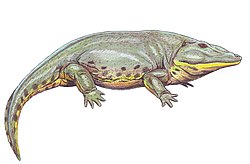| Kashmirosaurus Temporal range: Late Carboniferous or Early Permian | |
|---|---|
| Scientific classification | |
| Kingdom: | Animalia |
| Phylum: | Chordata |
| Clade: | Tetrapoda |
| Order: | † Temnospondyli |
| Family: | † Archegosauridae |
| Subfamily: | † Melosaurinae |
| Genus: | † Kashmirosaurus Werneburg and Schneider, 1996 |
| Type species | |
| †Kashmirosaurus ornatus (Woodward, 1905 [originally Archegosaurus ornatus]) | |
| Synonyms | |
| |
Kashmirosaurus is an extinct genus of temnospondyl amphibian known from Permo-Carboniferous deposits in the region of Jammu and Kashmir, India. [1] It was originally named by English paleontologist Arthur Smith Woodward in 1905 as a species of Archegosaurus called Archegosaurus ornatus. More recently, the species has been recognized as being distinct from Archegosaurus, and it was placed in its own genus Kashmirosaurus in 1996. An additional species of Archegosaurus, A. kashmiriensis, was named in 1960 from the same deposits in Kashmir, and is now considered synonymous with Kashmirosaurus ornatus. [2]



